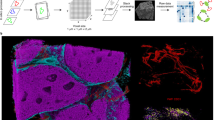Abstract
We apply a quantum diamond microscope for detection and imaging of immunomagnetically labeled cells. This instrument uses nitrogen-vacancy (NV) centers in diamond for correlated magnetic and fluorescence imaging. Our device provides single-cell resolution and a field of view (∼1 mm2) two orders of magnitude larger than that of previous NV imaging technologies, enabling practical applications. To illustrate, we quantified cancer biomarkers expressed by rare tumor cells in a large population of healthy cells.
This is a preview of subscription content, access via your institution
Access options
Subscribe to this journal
Receive 12 print issues and online access
$259.00 per year
only $21.58 per issue
Buy this article
- Purchase on SpringerLink
- Instant access to full article PDF
Prices may be subject to local taxes which are calculated during checkout


Similar content being viewed by others
References
Billinton, N. & Knight, A.W. Anal. Biochem. 291, 175–197 (2001).
Visser, T.D., Groen, F.C.A. & Brakenhoff, G.J. J. Microsc. 163, 189–200 (1991).
Issadore, D. et al. Lab Chip 14, 2385–2397 (2014).
Osterfeld, S.J. et al. Proc. Natl. Acad. Sci. USA 105, 20637–20640 (2008).
Gaster, R.S. et al. Nat. Med. 15, 1327–1332 (2009).
Lee, H., Sun, E., Ham, D. & Weissleder, R. Nat. Med. 14, 869–874 (2008).
Lee, H., Yoon, T.-J., Figueiredo, J.-L., Swirski, F.K. & Weissleder, R. Proc. Natl. Acad. Sci. USA 106, 12459–12464 (2009).
Issadore, D. et al. Sci. Transl. Med. 4, 141ra92 (2012).
Gambini, S., Skucha, K., Liu, P.P., Kim, J. & Krigel, R. IEEE J. Solid-State Circuits 48, 302–317 (2013).
Taylor, J.M. et al. Nat. Phys. 4, 810–816 (2008).
Pham, L.M. et al. New J. Phys. 13, 045021 (2011).
Le Sage, D. et al. Nature 496, 486–489 (2013).
Tang, L., Tsai, C., Gerberich, W.W., Kruckeberg, L. & Kania, D.R. Biomaterials 16, 483–488 (1995).
Yu, M., Stott, S., Toner, M., Maheswaran, S. & Haber, D.A. J. Cell Biol. 192, 373–382 (2011).
Doherty, M.W. et al. Phys. Rep. 528, 1–45 (2013).
Felton, S. et al. Phys. Rev. B Condens. Matter Mater. Phys. 79, 075203 (2009).
Fischer, R., Jarmola, A., Kehayias, P. & Budker, D. Phys. Rev. B Condens. Matter Mater. Phys. 87, 125207 (2013).
Acknowledgements
The authors thank M.L. McKee for help with electron microscopy, as well as M. Liong and H. Shao for advice on magnetic assay protocols. This work was supported in part by US National Institutes of Health grants R01HL113156 (H.L.) and U54-CA119349 (R.W.) as well as the US Defense Advanced Research Projects Agency (DARPA) QuASAR program and DARPA SBIR contract W31P4Q-13-C-0064.
Author information
Authors and Affiliations
Contributions
D.R.G. and R.L.W. designed and constructed the quantum diamond microscope. C.B.C., H.L. and R.L.W. conceived the application of the quantum diamond microscope to the task of rare-cell detection and devised the experiments. K.L., R.W. and H.L. developed the optimal protocol for magnetic labeling of cells. K.L. prepared magnetic nanoagents and carried out the cell labeling. D.R.G. and C.B.C. performed the experiments and analyzed the data. C.B.C., D.R.G., K.L., H.L. and R.L.W. wrote the manuscript, with discussion and input from all authors. A.Y., H.P., M.D.L. and R.L.W. conceived the application of NV diamond wide-field magnetic imaging to biomagnetism.
Corresponding authors
Ethics declarations
Competing interests
M.D.L. and R.L.W. are cofounders of Quantum Diamond Technologies, Inc. (QDTI). M.D.L., R.L.W. and A.Y. all serve on the Scientific Advisory Board of QDTI and have financial interests in QDTI. R.W. has financial interest in T2Biosystems. R.W.'s interests are reviewed and managed by MGH and Partners HealthCare in accordance with their conflict of interest policies.
Supplementary information
Supplementary Text and Figures
Supplementary Notes 1–5 (PDF 2362 kb)
Rights and permissions
About this article
Cite this article
Glenn, D., Lee, K., Park, H. et al. Single-cell magnetic imaging using a quantum diamond microscope. Nat Methods 12, 736–738 (2015). https://doi.org/10.1038/nmeth.3449
Received:
Accepted:
Published:
Issue Date:
DOI: https://doi.org/10.1038/nmeth.3449




